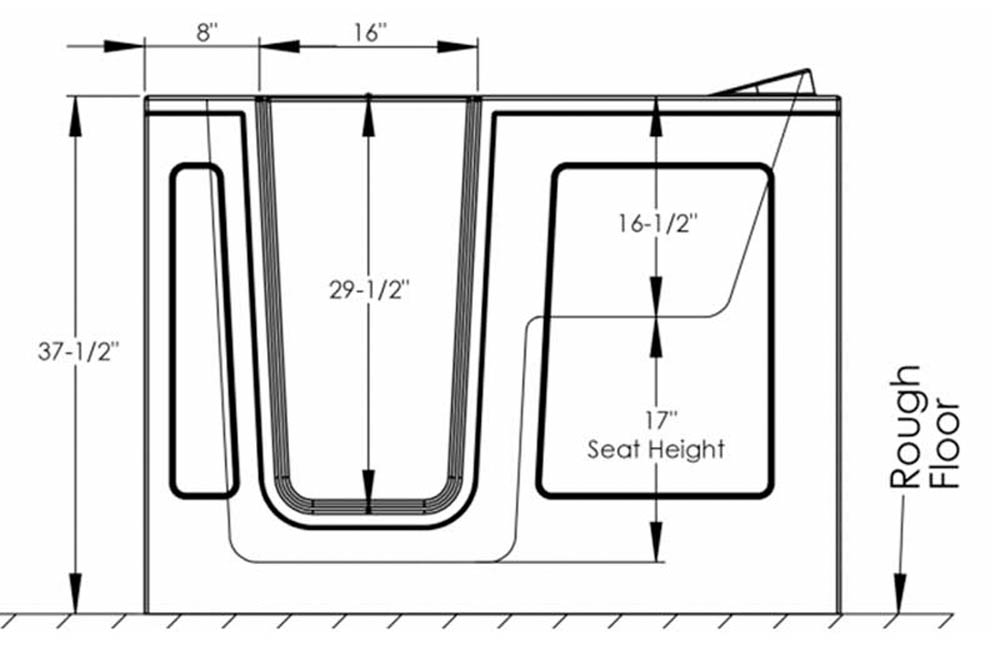As walk-in tub technology advances, the safety features improve. Walk-in tubs are common aging-in-place home additions because they allow you to bathe independently and privately. Each model will have different price points and a variety of comfort and safety features, making it harder to decide which is best for your bathroom.
After consulting an accessibility expert, we listed several factors and features to consider when choosing a walk-in tub.
Walk-In Tub Doors
The doors on a walk-in tub seal to contain water and help you remain steady as you enter to bathe. While most tubs come with an inward swinging door, outward opening doors are also available. Inward swinging doors are most common, but their design means that you cannot open them in an emergency without draining the tub first. (They use water pressure to stay closed.)
Outward swinging walk-in tub doors have a latching mechanism to make them watertight. These doors open quickly in an emergency without having to drain the entire bath, but the door handle can be difficult to use for someone with limited hand strength.
The bathroom must be wide enough to accommodate the door, and outward-swinging models are more expensive than walk-in tubs with an inward opening door. Some models have extra-wide doors to accommodate different transfer techniques and assistive devices like wheelchairs, and many tub doors can open left or right to accommodate safety rails.
Thresholds beneath the doors aren’t all the same, either. When shopping for a walk-in tub, consider the threshold height and be sure you can step over it without tripping. If the threshold height is a concern, ultra-low step-in profiles (about two inches high) are available on some models.
Jets or No Jets?
If cost is an issue, you can save by purchasing a basic walk-in tub. This type of tub will have safety bars and a handheld shower sprayer, but no other features. You can safely bathe and soak in one of these tubs.

If you have osteoarthritis and rheumatoid arthritis, back pain, a knee or hip replacement, fibromyalgia or other neurological conditions, consider your daily pain level. While soaking in a tub helps reduce pain, buying a walk-in tub with whirlpool or air jets offers a higher standard of hydrotherapy with a long list of health benefits like reducing muscle spasms, strengthening weak muscles, increasing joint range of motion, re-educating paralyzed muscles, and improving coordination and circulation. Look for tubs that provide targeted massaging jets for your problem areas, such as the back, legs or feet.
From Our Expert: Hydrotherapy has been shown to reduce pain and increase self-efficacy. However, bathers typically see the best results when paired with a plan of care created with your doctor that outlines the frequency and length of tub use and a physical routine guided by a rehab professional.
Dawn Heiderscheidt, OTR/L, ECHM, CAPS
Walk-in tubs with therapeutic jets also promote skin exfoliation, so if you have a skin condition, this is something to consider after discussing it with your doctor. Medicated or moisturizing lotions tend to be absorbed well after a jetted bath, too.
Walk-In Tub Size
The average walk-in bathtub measures 60 inches long and 32 inches wide, though some come as small as 36 1/2 inches long and 33 inches wide. Some manufacturers offer larger models for people who weigh more than 250 pounds or to accommodate wheelchair transfers and lift chairs.
There are several home requirements of walk-in tubs. When deciding what size tub you should get, first measure your home’s hallways, stairs, and doorways to ensure installers can move the tub to your bathroom. If your doors and hallways are very narrow or you have many steps in a narrow staircase, you might have to shop around to find one that fits. Your installer might recommend renovating your house to get the tub in, such as building a new bathroom in a more suitable spot or reconstructing narrow hallways or doorways.
For these reasons, it’s important to get multiple quotes from walk-in tub companies that compare installers and models that may work better for your particular home and situation.
From Our Expert: Walk-in tubs benefit many people, but sometimes, a walk-in tub is not the best option due to your medical conditions, limited mobility, condition progression, or environmental limitations. If you find this to be the case, contact a rehab professional who focuses on environmental modifications, as they may suggest a walk-in shower with multiple shower heads, hot tubs, or other ways to receive similar physical benefits.
Dawn Heiderscheidt, OTR/L, ECHM, CAPS
Walk-In Tub Installation Requirements
Ask your walk-in tub dealer about the weight of the tub, too. You’ll need to ensure your bathroom’s subfloor can carry the tub load—both when empty and filled with water. Remember, walk-in tubs hold more gallons of water than a standard bathtub, so the weight will be substantially higher.
Your contractor can check the subfloor to determine if modifications are necessary. Most walk-in tubs are designed to install where your current tub sits. If you need a larger walk-in tub than your existing one, budget for additional renovation costs.
Walk-In Tub Costs
While walk-in tubs cost more than a standard bathtub, it’s best to get one that meets your current and future needs. Walk-in tubs almost always require professional installation, which can add between $2,500 and $8,000 to your bill. Some companies include installation in their final prices. Based on our research, walk-in tubs cost from $3,000 to $20,000, including installation.
| Brand | Price Range | Brand Features |
|---|---|---|
| American Standard | $1,500 – $11,000 |
|
| Kohler | $4,000 – $12,000 |
|
| Premier Care | $3,000 – $8,000 |
|
| Safe Step | $2,500 – $10,000 |
|
| Universal | $2,000 – $7,000 |
|
by Manufacturer 2023
When budgeting for the total cost of a walk-in tub, you’ll also need to consider water capacity. If your existing heater is too small to adequately heat the water in the new tub, you’ll need to upgrade your water heater.
Unfortunately, Medicare does not consider these tubs durable medical equipment, so you must pay for a walk-in tub on your own. Still, many seniors find that the health and comfort benefits outweigh the cost after reviewing situation-specific recommendations from accessibility specialists or doctors.
Tips for Buying a Walk-In Bathtub
Walk-in tubs are not the cheapest devices available, and many require small renovations to install. Therefore, it’s important to do some research before making the investment.
- Set up an in-home consultation with the dealer and the installer. Most manufacturers will send a specialist to your home to assess your bathroom setup, tub needs, and installation requirements. Before signing a contract, make sure the company provides a detailed cost estimate, including warranty options, return policies, and care instructions.
- Determine your safety and health requirements versus your luxury wants. Walk-in tubs come with many safety and luxury features—some more applicable to your needs than others. Without a predetermined budget and list of “necessary” features, your final price quote could become unaffordable. Our expert recommends prioritizing a handheld shower head, lower thresholds, wider doors, grab bars, dual drains, seat cushion or riser if someone is of shorter stature, and adjustable water jets (for pressure and direction).
- Consult a plumber. We recommend letting a plumber assess your piping setup and water heater before choosing a walk-in tub. Many models offer quick-drain technology, but this feature depends on your plumbing system’s ability to handle a more significant water load. Depending on how the plumbing is wired, you might need to budget for additional work.
Bottom Line: Buying a Walk-In Tub
With door-based entryways and low step thresholds, walk-in tubs are a safer, more accessible way to age in place. Walk-in tubs also feature many additional luxury spa features that can help with certain medical conditions.
When buying a walk-in tub, shop the different manufacturers, models, and add-on features to determine which tub is right for you. Also, consult professionals and specialists who can advise whether a walk-in tub is worth the investment.



